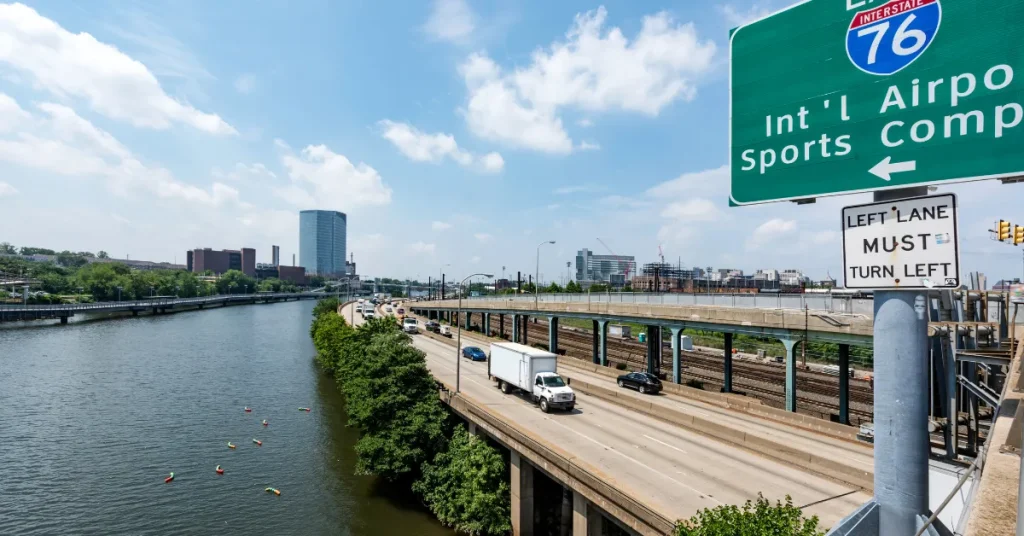The Schuylkill River has variable depths, averaging 5 to 6 feet in most places. Its deepest point is near the Fairmount Dam, reaching about 30 feet.
Nestled in the heart of Pennsylvania, the Schuylkill River serves as a picturesque backbone to the city of Philadelphia. Originating in the verdant Appalachian Mountains, the river stretches over 135 miles before merging with the Delaware River.
The Schuylkill is not just a sight for sore eyes; it plays a pivotal role in the region’s ecology and economy.
As a waterway, it supports recreational activities such as boating and fishing, enhancing local tourism. It also enriches the historical fabric of the area, with landmarks dotting its banks that echo tales of the past.
The river’s depth plays a crucial role in its navigability and the health of its ecosystem, ensuring its place as a valued natural asset within the community.

The Depths Of Schuylkill River
Exploring the depths of a river reveals its character and ecosystem.
The Schuylkill River, stretching across Pennsylvania, offers a dynamic underwater landscape.
Its depths vary considerably, serving as a haven for aquatic life and a challenge for navigators. Let’s dive into the variances along its course and discover what secrets the deepest points hold.
Varied Depths Along Its Course
The Schuylkill River is not one-size-fits-all. Its depth changes from shallow to deep as you travel from source to mouth.
- In rural areas, the river remains mostly shallow – ideal for wading and fishing.
- As you approach urban centers, depth increases, making it suitable for larger boats.
Seasonal changes also affect the river’s depth. Spring melts or storms can cause dramatic increases.
Deepest Points And Their Significance
The deepest points of the Schuylkill River hold ecological and historical importance.
| Location | Approx. Depth (feet) | Significance |
| Philadelphia | 30 | Maritime history; once a bustling port. |
| Conshohocken | 20 | Industrial growth; mills and factories. |
These deeper sections support recreational activities like boating and fishing.
They also serve as critical habitats for diverse fish species, contributing to the river’s biodiversity.
Historical Factors Influencing Depth
The Schuylkill River’s depth has not always been as you see it today. Years of human activity and natural events have shaped its bed. Understanding these historical changes can tell a lot about the river’s past and future.
Industrial Revolution And Dredging
The Industrial Revolution brought many factories to the river’s edge. More boats needed to move goods. This demand led to dredging, making the river deeper for large vessels. Without dredging, the river would not support big boats.
Floods And Siltation Over Time
Rivers naturally change when floods happen. Floods drop dirt and sand, called silt, into the river. Over time, this builds up and can make the river shallower. Regular floods mean more silt, affecting how deep the river is.
Ecological Impacts Of Schuylkill River Depth

The Schuylkill River, a vital waterway, has varying depths that significantly influence local ecosystems. River depth acts as a controlling factor for many ecological processes.
The resulting impact on habitats and water quality holds great importance for the river’s health and biodiversity.
Habitats In Deep And Shallow Zones
Within the Schuylkill River, depth defines habitats. Deep zones and shallow areas host different species, each adapted to their niche.
- Deep water zones provide a cool and stable environment for fish like the channel catfish.
- Shallow regions are crucial nurseries for young fish and other aquatic life, offering warmth and rich food sources.
Diverse plants and animals rely on this variety in depth for survival.
Depth And Its Effect On Water Quality
The river’s depth directly impacts its water quality, affecting everything that lives in and around it.
| Depth | Impact on Water Quality |
| Deeper areas | Typically cooler and better oxygenated, supporting diverse life. |
| Shallower parts | May experience higher temperatures and algae growth, affecting species balance. |
These variations contribute to the overall ecological balance of the Schuylkill River.
Navigating The Schuylkill River

To unravel the allure of the Schuylkill River, one must comprehend its depths. Not merely in physical terms, but through an understanding of its significance for transportation and recreation.
The Schuylkill, a historically vital waterway, poses both challenges and opportunities for those navigating its waters. Its depth varies significantly along its course, making knowledge of the river essential for safe and enjoyable use.
Boating And Shipping Activities
Recreational boating and commercial shipping are popular on the Schuylkill River.
| Depth (feet) | Activity |
| <5 | Small Craft Kayaking, Canoeing |
| 5-8 | Recreational Boating |
| 8+ | Commercial Shipping |
At depths exceeding 8 feet, larger vessels take precedence, benefiting trade and transportation. Shallower regions, often less than 5 feet deep, cater to kayaks and canoes.
Safety Measures For Deep And Shallow Parts
Nautically speaking, safety on the Schuylkill requires awareness of its varying depths.
- Personal flotation devices are crucial for all boating activities.
- Monitoring river depth charts helps to avoid submerged hazards.
- Being vigilant in shallow zones prevents damage to vessels and preserves wildlife.
In deeper parts, mariners should monitor channel markers and stay informed about commercial traffic. These measures ensure a harmonious and secure river experience for everyone.
Measuring Techniques And Recent Data
Understanding the depth of any river is crucial for ensuring safe navigation, assessing flood risks, and managing aquatic ecosystems.
With the Schuylkill River being a vital watercourse for Pennsylvania, current measurement techniques offer precise data for various uses.
Traditional And Modern Methods
Traditional approaches to measuring river depth involved simple tools like graduated sticks or sounding lines, known as lead lines.
These techniques, albeit still useful in some scenarios, give way to more advanced technologies. Modern methods incorporate sonar equipment, which sends sound waves into the water.
GPS devices help pinpoint exact measurement locations. Together, they create highly accurate depth charts. Drones and satellites provide aerial perspectives, further enriching data quality.
Latest Depth Readings And Trends
Recent readings of the Schuylkill River present a dynamic picture. Depth may vary due to factors like rainfall, dam releases, and seasonal changes.
Average depths generally range from 4 to 20 feet, with variations occurring along different segments of the river. Trend analysis reveals areas of sediment accumulation and erosion, vital for conservation strategies.
- Shallow zones near tributaries
- Deeper sections towards the middle
Data integration from various sources brings light to long-term changes in the river’s depth. Comprehensive maps and models are updated regularly to reflect the most current readings, pushing for enhanced river management and safety protocols.
Comparisons With Other Pennsylvania Rivers
Exploring Pennsylvania’s waterways reveals a tapestry of natural wonder. Each river tells its own story, especially when discussing depth.
Among these, the Schuylkill River offers a unique narrative. Let’s dive into how its depths measure against the sprawling Delaware and mighty Susquehanna.
Depth Contrast With Delaware And Susquehanna
The Schuylkill may not boast the same depths as some of its Pennsylvania siblings. Yet, it holds its own in stature and charm. The Delaware River, the lifeblood of the region, can reach depths exceeding 113 feet near Philadelphia.
Meanwhile, the Susquehanna, known for its historic significance, varies greatly but can plunge to over 60 feet.
| River Name | Notable Depth (feet) |
| Schuylkill River | Varies, up to 30 feet |
| Delaware River | Up to 113 feet |
| Susquehanna River | Over 60 feet |
Measured against these giants, the Schuylkill’s depth is more modest. It averages about 6-8 feet deep, with maximum recorded depths of approximately 30 feet.
Although it may not run as deep, its waters carve through the landscape, creating a serene environment.
Unique Features Of Schuylkill’s Depths
The Schuylkill River, with its undulating depths, offers distinct qualities. Several shallow stretches make it accessible for recreational activities like kayaking and rowing. In particular, areas around Philadelphia see a vibrant rowing community.
- Boathouse Row: Iconic and historical
- Fairmount Park: Offers tranquil views and diverse wildlife
- Shallow sections: Ideal for fishing and small watercraft
In comparison with its deeper counterparts, the Schuylkill’s varied depth creates distinct ecosystems along its banks. These ecosystems support a rich variety of fish and other wildlife—all thanks to the unique interplay of its depths.
FAQs About How Deep Is The Schuylkill River
What Is The Average Depth Of Schuylkill River?
The Schuylkill River’s average depth is around 6 to 20 feet. However, this can vary significantly with location, season, and rainfall levels. Certain sections may be shallower or deeper.
How Deep Does Schuylkill River Get?
At its deepest point, the Schuylkill River can reach depths of approximately 30 feet. Such depths are generally found near dams or deeper channels within the urban stretch of the river.
Where Is The Deepest Part Of Schuylkill River?
The deepest part of the Schuylkill River is typically found near the Fairmount Dam in Philadelphia. Here, the depth can reach up to 30 feet due to the dam’s influence on the river’s flow.
Does Schuylkill River Depth Vary By Season?
Yes, the depth of Schuylkill River can vary with the seasons. Generally, it is deeper in spring due to snowmelt and rainfall, and shallower during the dry summer months.
Conclusion
Discovering the depths of the Schuylkill River reveals its dynamic nature and historical importance. As you navigate its waters, remember, depths vary from 6 to 30 feet.
For fishing, boating, or simply enjoying riverside views, the Schuylkill invites exploration. Keep safety in mind, respect the waterway, and cherish the vibrant ecosystem within Philadelphia’s iconic river.
Resources:
1. https://www.nps.gov/scrv/index.htm
2. https://www.nps.gov/articles/000/schuylkill-river-trail.htm
